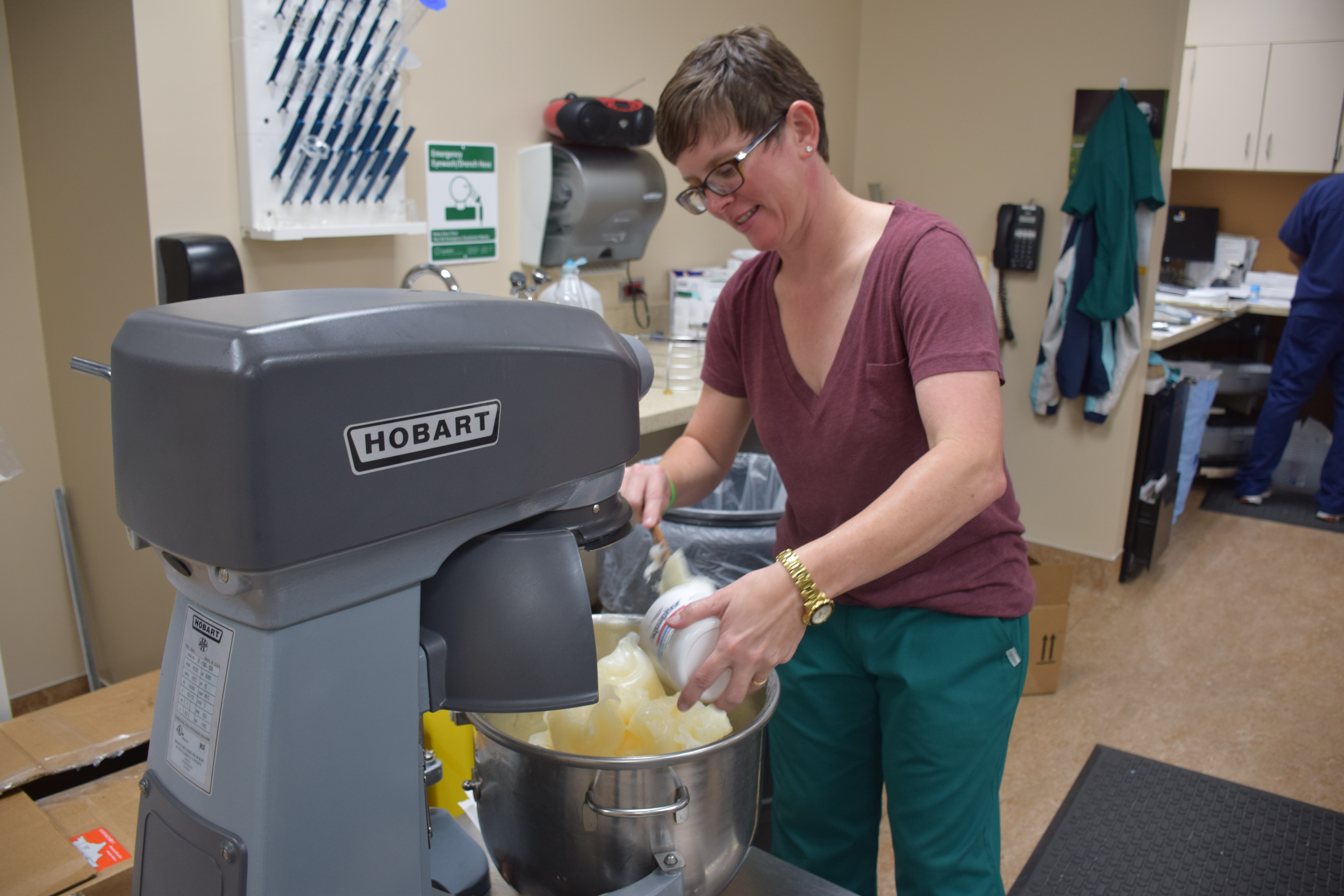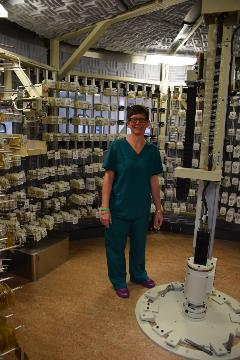
(Above) Shawn Carr making burn cream to be delivered to the Blocker Burn Unit. (Below) Carr stands inside the robotic prescription dispensing system in Central Pharmacy, which dispenses thousands of doses each day.
 Shawn Carr never imagined she would be responsible for operating a giant medication-dispensing robot when she started as a pharmacy tech at UTMB 25 years ago.
Shawn Carr never imagined she would be responsible for operating a giant medication-dispensing robot when she started as a pharmacy tech at UTMB 25 years ago.
“When I first started in outpatient pharmacy, we used a typewriter to process our prescription labels,” said Carr. “It’s pretty cool to see how much pharmacy has changed and evolved over the years.”
Located on the seventh floor of the new Clinical Services Wing, Carr and her colleagues at UTMB’s Central Pharmacy are responsible for dispensing and delivering about 6,000 doses of medications each day for hospital patients on UTMB’s Galveston Campus.
I get a glimpse of the futuristic robot when I meet up with Carr on a Wednesday morning. She leads me to a giant circular “cage,” which houses two large robotic arms and hundreds of commonly prescribed pharmaceutical drugs hanging on rods in bar-coded packages. The robot serves as a centralized drug distribution system that automates the storage, dispensing and restocking of inpatient medications.
Carr explains that once medications are ordered by doctors and reviewed by pharmacists, the robot’s electronic “eye” reads the barcode and the robotic arms pull the medication from the rod, depositing it into patient-specific boxes called cassettes. The cassettes are then loaded onto carts, which are delivered to units in the John Sealy Hospital and the TDCJ Hospital Galveston.
While I watch the robot in awe, Carr makes sure it’s stocked with “fast-moving” medications like heparin, a drug that prevents blood clots.
“What’s nice about the robot is that it runs 24/7 and never gets tired,” said Carr. “We have a big responsibility to get medications to patients as quickly as possible, so this robot helps us do it fast and efficiently. On a busy day in the hospital, it can produce anywhere from 3,500 to 4,000 doses.”
Drugs that are too big or too heavy to fit in the robot are put in the “carousel,” another automated storage and retrieval system for medications. When Carr scans the barcode on a patient label, the carousel’s shelves rotate and a light pops up, guiding Carr to the appropriate medication storage location.
When she’s not making sure the automated systems are stocked and running smoothly, Carr prepares personalized medications for patients. In a process called “compounding,” ingredients are mixed in the exact strength and dosage required to meet a patient’s specific needs.
“It’s just like cooking—I follow a recipe,” Carr says, as she begins transforming a blood pressure medication from a pill form into a liquid for a patient who has trouble swallowing. She crushes the tablets into a fine powder and adds sweet, pink syrup and a suspension agent into a beaker. Her attention to detail is obvious as she measures out the precise dosage and shakes it all together, then sets it aside for a final sign-off from the pharmacist on duty.
“Compounding is my favorite area—it’s all about patient care,” said Carr. “They are depending on us. If we don’t have a medication that works for a patient, we’ll try to make it for them.”
Carr shows me a filing cabinet bursting with recipes for everything from diaper rash cream to burn cream. She’s become close with the staff in the Blocker Burn Unit in John Sealy Hospital, as she spends hours every week preparing burn cream for wound care. Making a batch of the cream is a two-hour process that involves an industrial-sized mixer and ingredients such as healing ointment and the antibiotic bacitracin.
“I know it’s mixed well when it starts to look like banana pudding and has a thicker consistency,” said Carr. “By the time I finish, we’ll have three, one-and-a-half gallon buckets of burn cream that will make 36 wraps for wound dressing. That sounds like a lot, but one burn patient can use four wraps a day. I’ll probably need to make another batch after lunch, too.”
Carr also makes deliveries if needed. As we leave to deliver the cream to the burn unit, we run into another pharmacy tech, who’s rushing into an elevator to deliver important medication to another unit. I joke about how he must not need a gym pass for how much walking he does, and he tells me that he actually lost 25 pounds when he first started the job. I mentally add “physically fit” to my list of qualifications for pharmacy techs.
A few minutes and about a quarter-mile walk later, we enter the burn unit. “We’re hooking you up!” Carr shouts as she greets Nelly Garza, a patient care technician who uses the burn cream for wound dressings. You can tell the two women take their jobs seriously, but also know how to take a minute to smile in what can be a fast-paced and emotionally exhausting environment.
As we walk back to the Clinical Services Wing, I realize how little I understood about the pharmacy before meeting Carr that morning. Pharmacists and pharmacy techs are not “just pill counters,” they are a vital part of the health care system. UTMB’s pharmacy team makes sure patients get the appropriate medication in the right dose at the right time. They play a critical role in preventing medication errors, advising prescribers on medication choices, and ensuring safe and effective medication use so patients have the best possible outcomes.
“What we do makes a difference in the lives of our patients, from newborns to patients in hospice care,” Carr said. “It’s a lot of responsibility, but that motivates me to do my best. I know I’m my best self when I’m at work.”